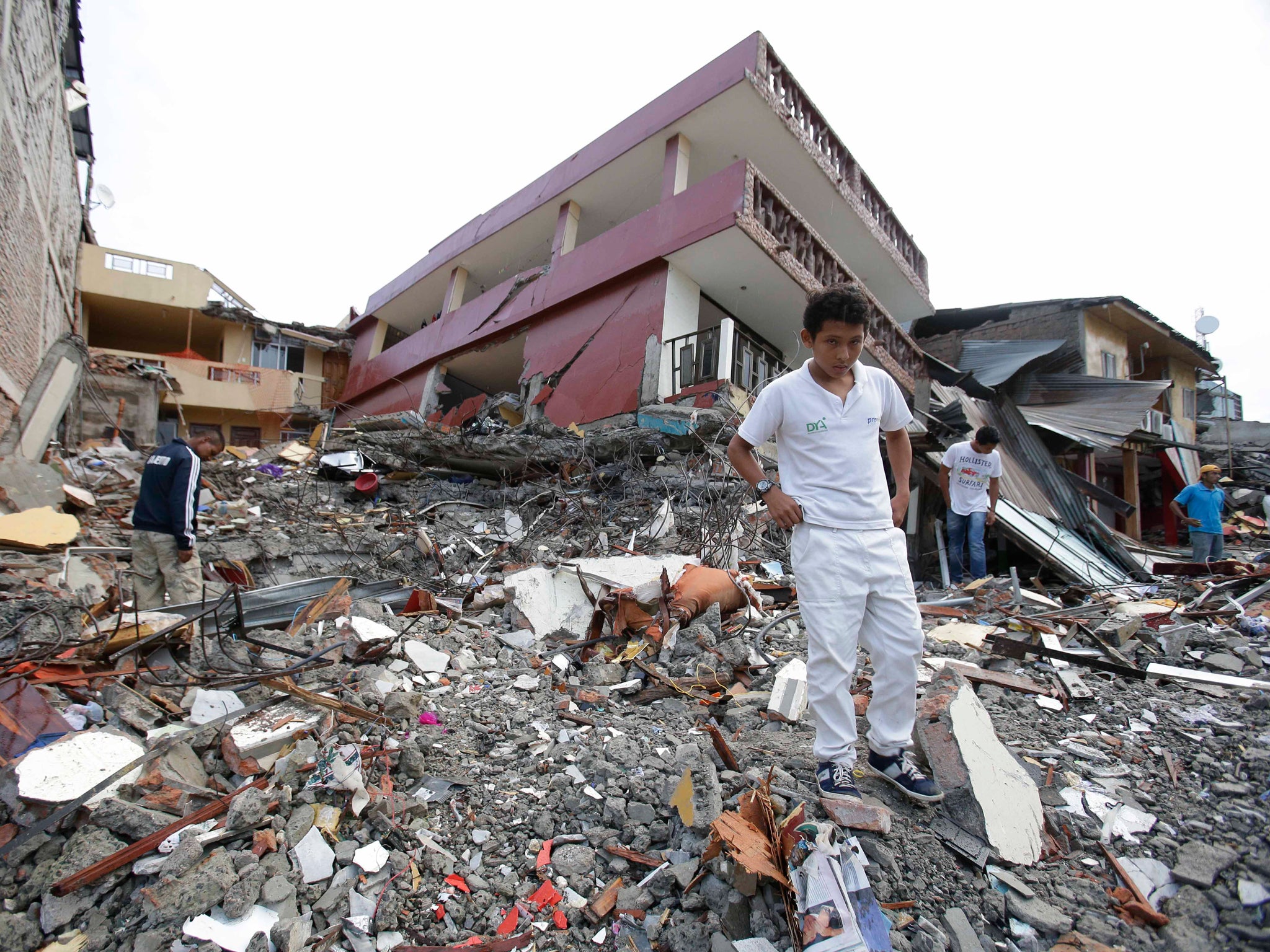Ecuador earthquake: Death toll rises to 350 after 7.8 magnitude quake - with over 2,500 injured
The quake's 7.8 measurement equals that of the 1906 earthquake that reduced the city of San Francisco to rubble

Your support helps us to tell the story
From reproductive rights to climate change to Big Tech, The Independent is on the ground when the story is developing. Whether it's investigating the financials of Elon Musk's pro-Trump PAC or producing our latest documentary, 'The A Word', which shines a light on the American women fighting for reproductive rights, we know how important it is to parse out the facts from the messaging.
At such a critical moment in US history, we need reporters on the ground. Your donation allows us to keep sending journalists to speak to both sides of the story.
The Independent is trusted by Americans across the entire political spectrum. And unlike many other quality news outlets, we choose not to lock Americans out of our reporting and analysis with paywalls. We believe quality journalism should be available to everyone, paid for by those who can afford it.
Your support makes all the difference.The death toll from the 7.8 magnitude earthquake which struck Ecuador has risen to 350, the country's president has said. At least 2,527 people are known to be injured.
The number of fatalities has risen several times, according to president Rafael Correa, and it is still rising.
Emergency services fear more people are trapped under the rubble, while traumatised survivors are sitting amidst their ruined homes, according to Reuters.
Mr Correa first said there had been 233 casualties on Twitter, where he said the town of Pedernales had been "destroyed."
“We're trying to do the most we can but there's almost nothing we can do,” said the mayor of Pedernales, Gabriel Alcivar. Pedernales is a town of approximately 40,000 that was near the epicentre of the quake, the Associated Press reports. “This wasn't just a house that collapsed, it was an entire town.”
Mr Alcivar pled for officials to send emergency workers and earth-moving machines to sort through the rubble. Looting had broken out in the chaos that ensued, but he said that local authorities were too pre-occupied with trying to save lives to regain control of the city.
Vice President Jorge Glas was on the scene within hours of the quake. He said in a televised statement that deaths in the South American country stretched as far as the cities of Manta, Portoviejo, and Guayaquil, hundreds of kilometers away from the epicenter. He said that some 10,000 troops were being deployed to assist the regions affected by the earthquake; 4,600 national police were en route to the towns near the centre that were hit hardest.
In the wake of the largest earthquake to hit Ecuador since 1979, more than 588 people were reported injured after the quake flattened buildings and buckled highways.
Mr Correa declared a national emergency and rushed home from a visit to Rome, urging Ecuadoreans to stay strong while authorities handle the disaster.
"Everything can be rebuilt, but what can't be rebuilt are human lives, and that's the most painful," he said in a telephone call to state TV before departing Rome straight for Manta.
He said in a later interview that the damage will cost billions of dollars.
The US Geological Survey [USGS] said the shallow quake, the strongest to hit Ecuador since 1979, was centred on south-southeast of Muisne, an area of fishing ports popular with tourists.
Kumamoto registered a 6.8 magnitude quake on Thursday, followed by a 7.0 magnitude the next day. Forty-one people were killed and roughly 1,500 people were injured.
The 7.8 measurement of the earthquake in Ecuador matches that of the 1906 earthquake that reduced the city of San Francisco to rubble, according to USGS figures.
David Rothery, Professor of Planetary Geosciences at The Open University, said that the 7.8 magnitude of the earthquake meant that "shaking at its underground source was about six times stronger than in the magnitude 7.0 earthquake in southern Japan just over a day before. The total energy involved was probably about 20 times greater."
He said it was caused by the floor of the Pacific Ocean (the Nazca plate) being moved below South America. "The greater damage to buildings and the probable greater loss of life in Ecuador may reflect poorer adherence to seismic building codes in the construction of buildings and bridges."
The fact that the epicentre of the earthquake was onshore meant that the damage was greater than if it had been offshore, he added, but that if it had been offshore "there would have been the potential to displace the ocean water strongly enough to cause a tsunami powerful enough to cause damage on both local and more distant coastlines."
There was no causal relationship between the earthquakes in Ecuador and Japan, he said.
Join our commenting forum
Join thought-provoking conversations, follow other Independent readers and see their replies
Comments